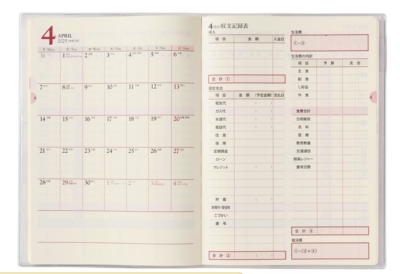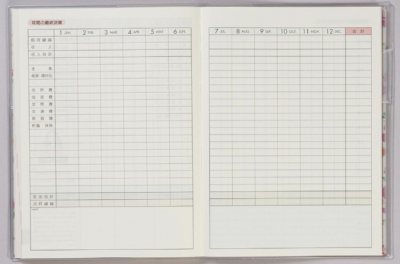In my trawling of various websites that sell Japanese notebooks, I’d often noticed a lot of listings for “household account books.” I figured using a notebook to track household finances must be common or traditional in Japan, but I never knew the full story behind it until I finally decided to do some research and discovered the Japanese word for these account books: Kakeibo.
Kakeibo can be translated as household account book or household financial ledger, but the word has come to mean more than just a book where you write your expenses. It’s a whole method of budgeting and planning your savings goals, introduced in 1904 by Japanese journalist Hani Motoko. Household spending was traditionally managed by women in Japan: husbands worked and brought home their salary to their wives, who then decided how the cash would be divided out and budgeted for various expenses. They used household account books to keep track.
Though gender roles may be less rigid today, the basic rules for tracking personal finances still apply. The Kakeibo method begins with setting a savings target. You record your income and fixed expenses for the coming month, and set a goal for how much you’ll save. Expense tracking is divided into 4 major areas, called “pillars”: Needs, Wants, Culture and Unexpected is the usual framework, but this could be adjusted to a particular user’s needs. I personally love that it prioritizes culture as its own pillar! Each week, you write down everything you spend, with the amount in a column for its corresponding pillar. Then at the end of the week and/or month, you summarize and reflect on where things stand, summarizing how much money you have, how much you spent, how much you saved, and how you can improve and save more over the long term.
Hani Motoko’s method obviously became popular enough that the household account book became its own genre of stationery publishing in Japan. Though I could not find any information on early iterations of these notebooks or how they’ve changed over the years, a huge variety of them seem to be sold today. The designs still target women as you can see from the covers of these Pagem kakeibo planners.

The layouts inside vary– some allow for some appointment tracking but others devote most of the weekly layout to recording expenses. Each month has a page for a summary. Notes pages are also included



Below are some layouts from an undated Hakubunkan brand kakeibo planner:



And here’s a version by Takahashi:



There are, of course, lots of other ways to track your spending and saving and budgeting. I used to jot various notes about my spending in paper notebooks back in the 1980s and 1990s, though I wasn’t very methodical about it. I’d also go through all my records a few times a year and assess the bigger picture, adding up long lists of numbers. When I discovered Excel, those lists became spreadsheets, and when I got a Palm Pilot I started tracking all my expenses in an app that synchronized with a desktop program. This is one area where digital tracking has served me well and I’ve never looked back. But I do still jot a savings goal in my planner every year. And reading about the Kakeibo method is making me wonder if I should be using my notebooks to track my finances in more detail, at least in terms of a monthly recap.
Nowadays there are apps for Kakeibo too– but the key thing about the Kakeibo method is how it incorporates mindfulness and reflection about spending. And just as writing by hand in paper notebooks and reading paper books can help you retain information better, devotees of the Kakeibo method say that the act of writing their spending and savings goals in a paper account book helps them improve their money management and save more. Makes total sense to me!
If you want to learn more about Kakeibo, these books have more information about the method:
Kakebo: The Japanese Art of Mindful Spending
Kakeibo: The Japanese Art of Saving Money
Though most Kakeibo planners are in Japanese, I did notice these English-language versions:
English-language Kakeibo planner in assorted other designs
Another English Kakeibo planner
You can also read more about the Kakeibo method at these sites:


Attractive and very timely, with the approach of the new year. Thanks!